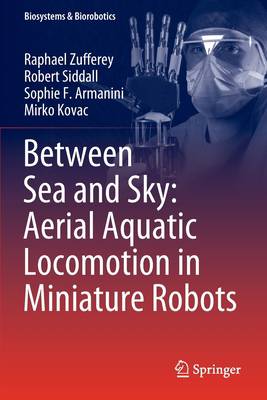
- Afhalen na 1 uur in een winkel met voorraad
- Gratis thuislevering in België vanaf € 30
- Ruim aanbod met 7 miljoen producten
- Afhalen na 1 uur in een winkel met voorraad
- Gratis thuislevering in België vanaf € 30
- Ruim aanbod met 7 miljoen producten
Between Sea and Sky: Aerial Aquatic Locomotion in Miniature Robots
Raphael Zufferey, Robert Siddall, Sophie F Armanini, Mirko KovacOmschrijving
This book reports on the state of the art in the field of aerial-aquatic locomotion, focusing on the main challenges concerning the translation of this important ability from nature to synthetic systems, and describing innovative engineering solutions that have been applied in practice by the authors at the Aerial Robotics Lab of Imperial College London. After a general introduction to aerial-aquatic locomotion in nature, and a summary of the most important engineering achievements, the book introduces readers to important physical and mathematical aspects of the multimodal locomotion problem. Besides the basic physics involved in aerial-aquatic locomotion, the role of different phenomena happening in fluids, or those due to structural mechanics effects or to power provision, are presented in depth, across a large dimension range, from millimeters to hundreds of meters. In turn, a practice-oriented discussion on the obstacles and opportunities of miniaturization, for both robots and animals is carried out. This is followed by applied engineering considerations, which describe relevant hardware considerations involved in propulsion, control, communication and fabrication. Different case studies are analyzed in detail, reporting on the latest research carried out by the authors, and covering topics such as propulsive aquatic escape, the challenging mechanics of water impact, and a hybrid sailing and flying aircraft. Offering extensive and timely information on the design, construction and operation of small-scale robots, and on multimodal locomotion, this book provides researchers, students and professionals with a comprehensive and timely reference guide to the topic of aerial-aquatic locomotion, and the relevant bioinspired approaches. It is also expected to inspire future research and foster a stronger multidisciplinary discussion in the field.
Specificaties
Betrokkenen
- Auteur(s):
- Uitgeverij:
Inhoud
- Aantal bladzijden:
- 247
- Taal:
- Engels
- Reeks:
- Reeksnummer:
- nr. 29
Eigenschappen
- Productcode (EAN):
- 9783030895778
- Verschijningsdatum:
- 5/01/2023
- Uitvoering:
- Paperback
- Formaat:
- Trade paperback (VS)
- Afmetingen:
- 156 mm x 234 mm
- Gewicht:
- 381 g

Alleen bij Standaard Boekhandel
Beoordelingen
We publiceren alleen reviews die voldoen aan de voorwaarden voor reviews. Bekijk onze voorwaarden voor reviews.











